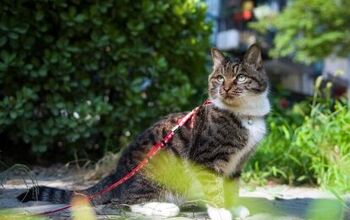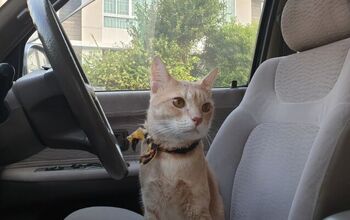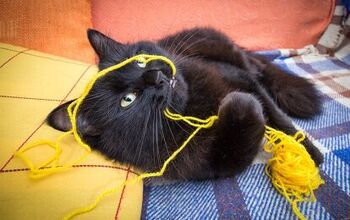Are Laser Toys Safe for My Cat?

It’s a classic feline spectacle, the tiny red dot that transforms your cat instantly into a furry ninja, chasing and leaping with unmatched intensity. But have you ever stopped to wonder… are laser toys really safe?
The mesmerizing dance of the red dot has long captivated cats, from traditional laser pointers for fun interactive play with their human companions to automatic laser toys. However, somewhere amidst the playful leaps and bounds, many cat parents are now starting to express concerns about the potential risks these toys may pose.
Are they genuinely harmless, or are there hidden dangers lurking beneath the surface of this seemingly innocent game? The truth is that it isn’t black and white.
In this post, I will provide a balanced look at laser toy safety, addressing some of the most common concerns and offering practical tips to ensure your cat continues to enjoy safe, enjoyable play sessions, whether with or without the laser pointer.
The Appeal of Laser Toys to Our Cats
What is it about that little red dot that drives cats wild? The dancing light taps into your cat’s predatory instincts. As it darts across the floor, it mimics the movement of small prey, triggering their natural hunting drive. Think of it like a little bug skittering across your floor, the perfect target for your kitty to go after.
This translates into some great benefits, especially for indoor cats who often don’t have the same opportunities for physical exercise and to use their hunting skills. Laser play sessions are an excellent outlet for pent-up energy, promoting heart health, and preventing unwanted weight gain.
Beyond the physical benefits, laser toys offer valuable mental enrichment, engaging your cat’s focus and problem-solving skills as they use their brain to figure out the best approach to catch their prey. The shared experience of playing together is also a great way to strengthen your bond with one another, creating moments of joy and connection.
Finally, one of the major reasons these toys appeal so much to cat parents is the price point and ease of use. Rather than investing in expensive or complicated toys, laser pointers offer a quick, easy, and budget-friendly way to entertain even the pickiest cats. Plus, there’s an entertainment factor for us, too – who doesn’t love watching their cat go crazy chasing the laser across the room?
Potential Risks and Concerns
While there is no denying that laser toys are a fun option for entertainment, it’s crucial that, as loving, responsible cat parents, we understand the potential risks they pose so we can make the best decision for our feline family members.
Eye Safety
One of the biggest dangers associated with the use of laser pointers is the risk of eye injuries. Direct exposure to the concentrated laser beam can cause serious and potentially irreversible damage to your cat’s retina, leading to impaired vision and even blindness. Never, under any circumstances, should you point the laser directly into your cat’s eyes.
Behavioral Concerns
Cats are natural hunters, but their instincts and desires to hunt often revolve around a set sequence – stalking, chasing, pouncing, and finally, capturing their prey. That same sequence carries over into play that mimics hunting.
Laser pointers work well to trigger the first stages of this sequence, tempting them to chase the elusive, darting light around the room. However, the concern lies in the fact that the “prey” is never truly caught. While this doesn’t bother all cats, some will find the inability to complete the hunting sequence frustrating.
Over time, this lack of fulfillment in their hunting sequence can lead to the development of obsessive-compulsive behaviors. You might observe your cat becoming fixated on any small light or shadow, especially if it moves even the slightest bit. They may also engage in repetitive, seemingly aimless behaviors, or develop anxiety and create a general sense of unease in your cat.
Physical Safety Hazards
Not all risks revolve directly around the use of the laser. When playing with a laser toy, most cats do so with impressive focus and excitement. This can quickly override their awareness of their surroundings, opening the door for accidents and injuries.
Cats have been known to run into furniture, walls, or other obstacles in pursuit of that little red dot. There’s also a risk of falls, especially if your cat tends to scale furniture, cat shelves, and other surfaces to get to their prey.
Psychological Impact of Laser Toy Play
Beyond the frustration of being unable to catch their “prey,” the consistent lack of a physical reward can have a deeper psychological impact. Cats experience a unique sense of satisfaction with a successful hunt, one that is deeply ingrained. After all, a cat in the wild is obviously hunting to eat or feed their young. Too many “failed hunts” can lead to a sense of dissatisfaction and even learned helplessness.
In time, your cat may start to associate playtime with frustration rather than enjoyment. This can lead to several behavior challenges, including redirected aggression. When your cat cannot catch the red dot, their prey, they may redirect that pent-up energy and frustration towards other targets, such as your hands, feet, or even other pets in your home.
Best Practices for Safe Laser Toy Use
Do you have a cat who LOVES their laser toy, and now you’re second-guessing your decisions as a cat parent? Even with the potential risks, you can still include laser toys in your cat’s play and enrichment as long as they are used responsibly. The following best practices will help minimize the dangers and ensure playtime continues to be both safe and fun.
Choosing the Right Laser Toy
When shopping for a laser pointer, stick to a product specifically labeled for pet use. They are typically low-powered and designed to minimize the risk of eye damage. Avoid using high-powered or industrial laser pointers made for presentations, construction, or other purposes, as these increase the threat of eye injuries.
Look for a safety rating on the packaging or product listing for any laser pointer or laser toy you are considering. If you’re unsure, err on the side of caution and choose a product specifically labeled for pet use, like the PetSafe Dancing Dot Laser Cat Toy (a hit in our house).
Safe Play Guidelines
Implementing safe play is also critical during laser toy sessions. Always actively supervise your cat during playtime to ensure they don’t run into hazards or that the laser beam isn’t inadvertently directed into their eyes. If you’re using an automatic laser toy, make sure you’re familiar with where to find the off switch in a hurry.
Remember the golden rule: never, ever point the laser directly at your cat’s eyes.
Keep play sessions relatively short and highly engaging rather than long and drawn-out. This helps to allow for fun and entertainment without crossing the line into overstimulation and frustration. To make the game more stimulating, vary the laser’s movements. This will mimic the erratic movements of prey, allowing for moments of stillness and sudden bursts of speed.
Before starting, take a moment to consider your cat’s play area. Tidy up any obstacles they may trip over or collide with during play. This includes not only other cat toys or clutter like shoes but also larger hazards like footstools or large décor items.
Ending the Hunt with a Reward
One of the easiest concerns to address is the inability of your cat to complete the hunting cycle. While there is no way to allow your cat to actually catch the laser, you can provide a satisfying conclusion to their play.
Instead of simply stopping abruptly, transition the beam onto a tangible toy or treat, such as a small plush mouse, a crinkly ball, or a tasty snack toward the end of the play session. Encourage your cat to “catch” this physical object, allowing them to finally engage in the final steps of hunting and grab onto their “prey.” This act of catching something will fulfill their natural predatory instincts and prevent the frustration and other psychological issues that laser toy play could otherwise trigger.
Recognizing the Signs of Overstimulation
Even with all these safety measures in play, there is the risk of your cat becoming overstimulated. Some cats will even experience this struggle with non-laser toys. Therefore, it’s important as a responsible cat parent to be tuned into your cat’s behavior and learn how to recognize the signs of stress or overstimulation during play.
Warning signs to watch out for include:
- Dilated pupils
- Flattened ears
- Excessive panting
- Hissing or Growling
- Fur standing on end
- Tucked tail
- Tense body posture
You may also notice your cat is shifting from playful chasing to more agitated or aggressive play behavior. If you notice any of these signs, it’s time to immediately end the play session. You can always play again later when your cat has had time to calm down.
Understanding your cat’s individual limits and knowing when to end playtime is essential for their well-being. Pushing them beyond their comfort level can lead to the development of negative associations with playtime and contribute to anxiety, redirected aggression, or other behavioral challenges.
Alternatives to Laser Toys
If, after reading all of this, you feel that laser toys aren’t the best option for your cat’s playtime, you may be searching for an alternative. It can also be beneficial to incorporate a variety of different toys into their playtime routine to keep playtime interesting, providing a more well-rounded and fulfilling experience.
Many fun, interactive cat toys are available that offer physical and mental stimulation without the potential downsides of laser pointers. Some options to consider include:
- Wand toys: These fishing pole-like toys feature feathers, strings, or other enticing attachments. They are a fun way to allow your cat to stalk, chase, and ultimately “capture” their prey in a tangible way while creating play sessions that also include their favorite playmate, you.
- Puzzle toys and treat dispensers: These toys will challenge your cat’s problem-solving skills as they work to access hidden rewards or even their daily meal. They are an excellent option for providing valuable mental enrichment.
- Scratchers: These toys and cat furniture options cater to your cat’s sensory and natural scratching behaviors. Scratching helps calm your cat and is a natural form of stress relief.
- Robotic toys: These toys provide unpredictable movement, engaging your cat’s attention even if you’re busy. Some also have remotes, allowing you to take control if you want a more interactive play experience.
Providing a diverse assortment of toys is crucial, especially in the early days after adding a cat to your home, because cats, like humans, have different play styles and preferences. Some may enjoy batting and pouncing, while others prefer chasing or problem-solving. By offering a range of options, you can be sure that there is always something there that will capture their interest.
If you have a large enough number of toys, consider rotating them regularly. Doing so can help to prevent boredom and maintain engagement. To do this, divide your cat’s toys into two or three separate groups, leaving one out and putting the others away in a secure cupboard. Every few days or weeks, switch out the toys they have access to for some “old” favorites as if they were new. This is also a great way to get the most out of your cat toy budget!
Leverage Cat Laser Toys in a Safe and Fun Way
While laser toys can be a convenient and entertaining option, we must ensure we are carefully considering their use. By learning the potential risks, from eye safety concerns and frustration of an unfulfilled hunt to physical hazards and psychological impacts, you can take steps to keep your cat safe throughout their play session.
Key ways to reduce the risk include always choosing appropriate low-powered laser toys, sticking to strict safety guidelines, always supervising play, setting up a safe play area, and ensuring there is always a satisfying “Catch” at the end of each play session.
With careful consideration and mindful practices, you can ensure that playtime, whether it involves a dancing red dot or another engaging toy, is both fun and safe for your kitty.
Join the PetGuide community. Get the latest pet news and product recommendations by subscribing to our newsletter here.

Britt Kascjak is a proud pet mom, sharing her heart (and her home) with her “pack” which includes her husband John, their 2 dogs – Lucifer and Willow – and their 3 cats – Pippen, Jinx, and Theia. She has been active in the animal rescue community for over 15 years, volunteering, fostering and advocating for organizations across Canada and the US. In her free time, she enjoys traveling around the country camping, hiking, and canoeing with her pets.
More by Britt
























